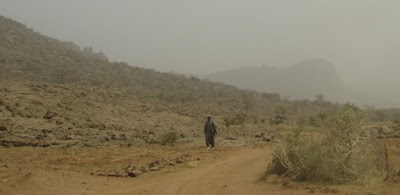Coming into Bourem we left the river and travelled over a wide empty plain, then an area of sand with many interwoven tracks. We camped among some low dunes a little south of the town.
There are villages every few miles, so we were not surprised to have some visitors for the evening, and morning. In Gao we pulled in at the Sahara Passion hotel for a shower, lunch, and filled our water tanks. They have a nice shady courtyard full of birds, a relief from the heat, which is in the mid 40s. We registered with the police, as advised by the guidebook and hotel staff. The officer offered to stamp us out of Mali to save time at the border - for a fee - but we declined.
We camped again half way between Gao and the border. It was hard to find a spot remote from the villages that are string along the river. As we cooked dinner, we had two mean arrive separately, one who sat silently and another who chatted. We shared our food, and then when I was on the other side of the vehicle, the friendly one came around and whispered to me that the other man was a bandit, and was going to target us in the night. I said thanks, and we quickly packed up and drove back to the most recent police post. The policeman is exceptionally nice, and told us he does a week’s posting there, night and day, before moving to another town. But there is little traffic, and none at night. In fact the only vehicles we see on the route south are those working on a major upgrade of the road, which will be tarred to the Niger border, and the occasional bus. (This incident was to be the only time I felt at risk during the journey. In the following years, this area became a no-go zone, rife with kidnappings, ambushes and jihadis).
The border formalities were very smooth on both sides. On the Niger side the officer said "Sinn Fein" when he saw the Irish passports. The granaries are different now, built in large beehive shapes with little straw hats over the openings at the top.
The tarred road reappeared, and we pulled in under a tamarind tree for a salad of potato, tomato and sausage with oil and vinegar dressing.




















































